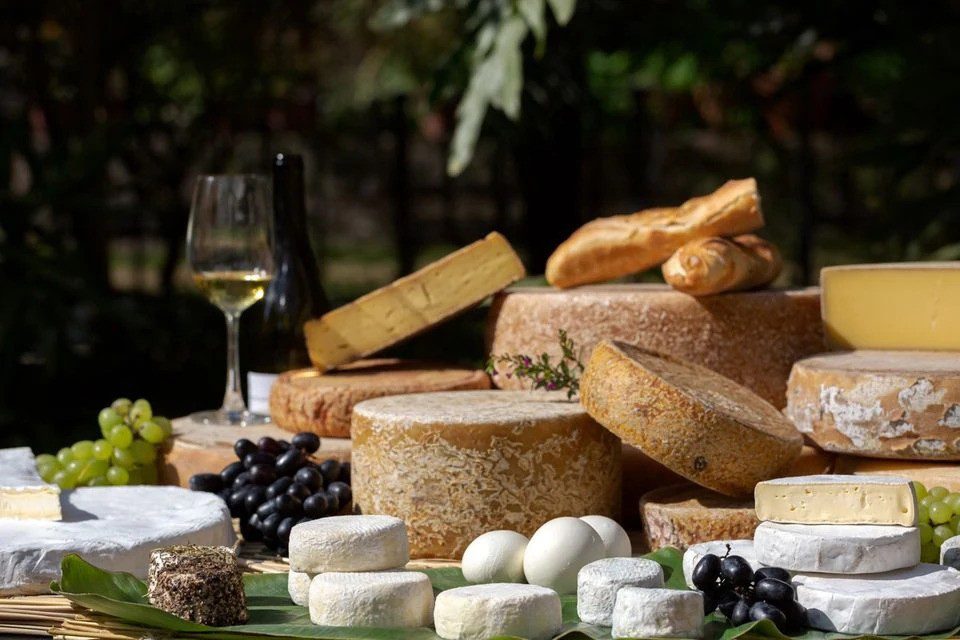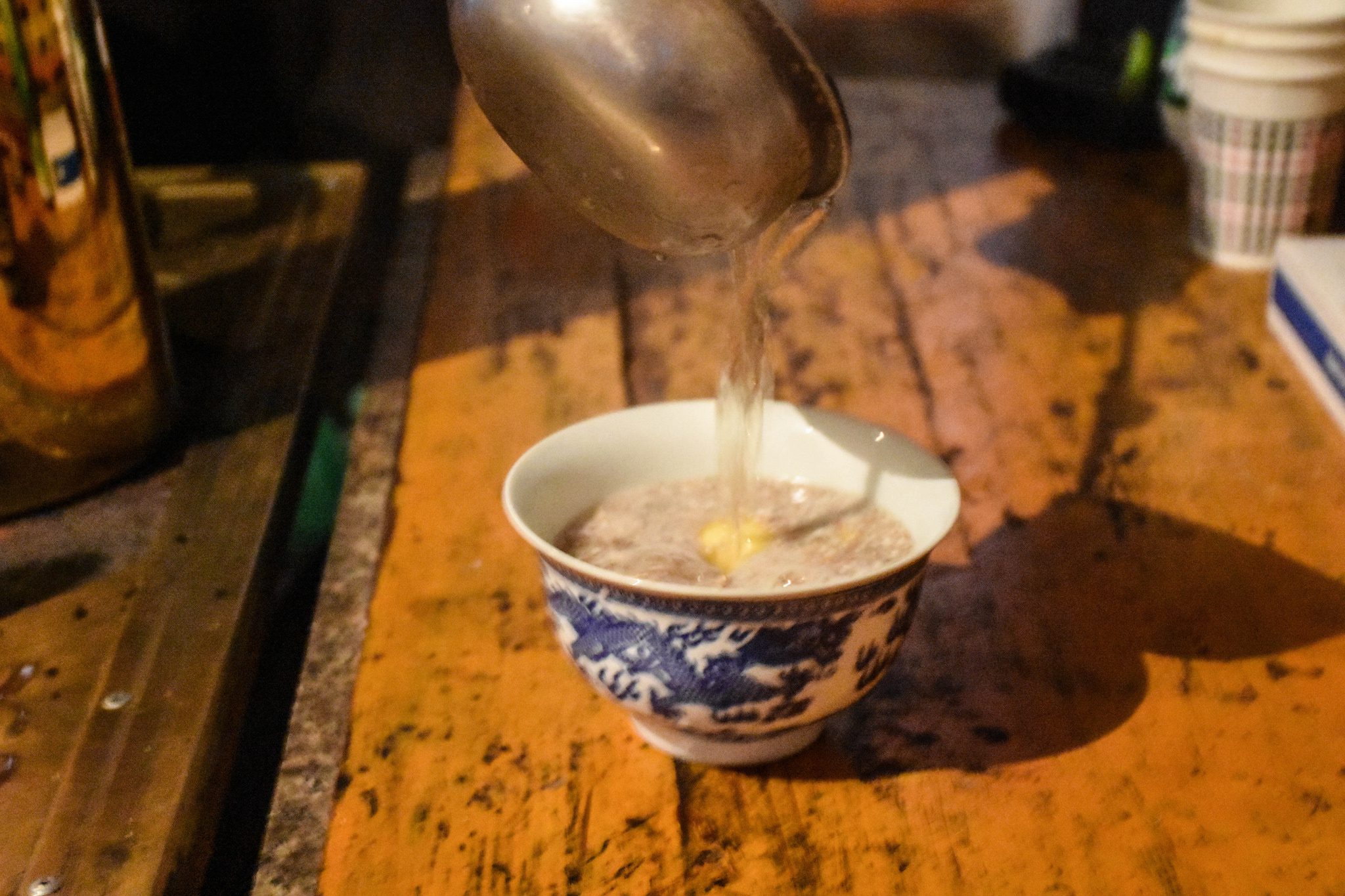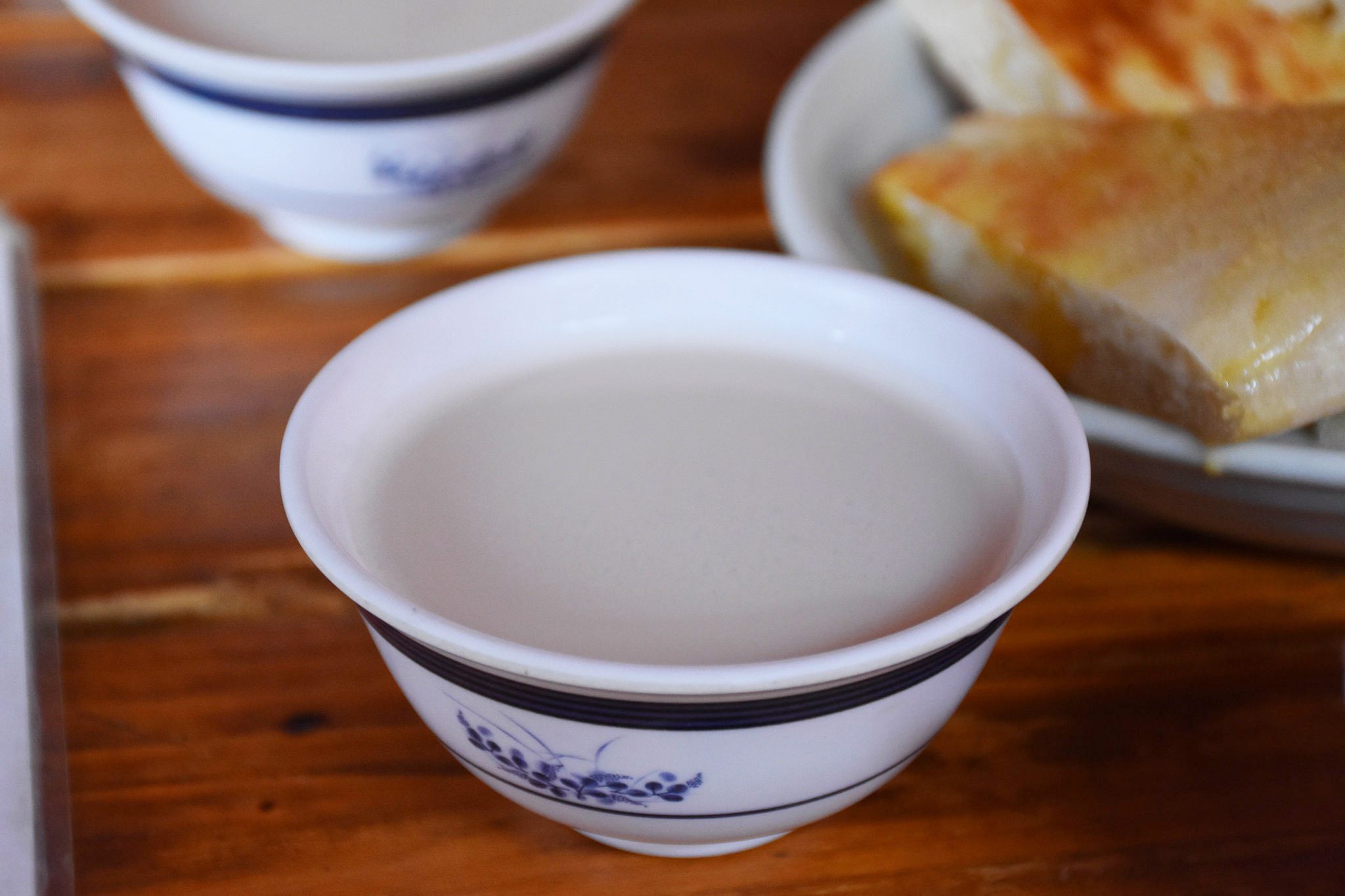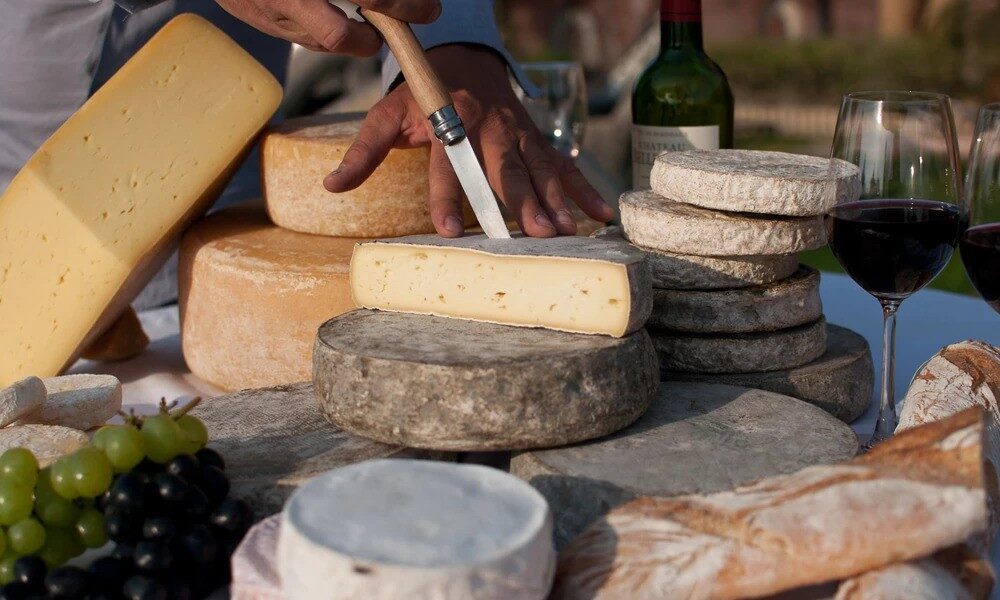Yak Cheese and Himalayan Butter Tea are central to the remote region of Ladakh, nestled in the Indian Himalayas, which boasts a culinary culture shaped by its high-altitude environment and ancient traditions. Two of the most iconic foods from this region are yak cheese and Himalayan butter tea. These staples have nourished the people of Ladakh for centuries, providing the necessary warmth, energy, and nutrition to thrive in the harsh Himalayan climate. This blog delves deep into the cultural significance, unique flavors, and health benefits of these foods, as well as how they are made and where you can experience them.
The Cultural Significance of Yak Cheese in Ladakh
What is Yak Cheese?
Yak cheese plays a crucial role in Ladakh’s traditional food culture. Derived from the milk of the region’s sturdy yak herds, it is a product of necessity, crafted by nomadic herders who rely on it for sustenance in the cold, barren landscapes.
Yak cheese, sometimes referred to as chhurpi (a hardened version), is known for its robust and earthy flavor. Rich in proteins, fats, and essential nutrients, it has become an integral part of high-altitude diets in Ladakh. In these mountainous regions, yaks are invaluable not only for their ability to navigate difficult terrain but also for their milk, which is transformed into various dairy products, including cheese, butter, and yogurt.
How Yak Cheese is Made
The production of yak cheese is a labor-intensive process, passed down through generations of Ladakh’s yak herders. The cheese-making begins with milking the yaks, a task that requires great skill and patience. The milk is boiled and mixed with a natural coagulant, often the sap of a local plant. The curds are then separated from the whey and pressed into molds. The cheese is typically left to dry and ferment for several weeks, which gives it its signature tangy taste and hard texture.
Types of Yak Cheese
Yak cheese comes in several varieties, ranging from fresh and soft to hardened and fermented. The most famous variety, chhurpi, is a hardened cheese that is chewed like gum. This form of cheese is especially popular among nomadic herders, who need food that can last long treks through the mountains. Soft varieties of yak cheese are often used in cooking, adding a rich, creamy texture to traditional dishes.

The Unique Taste and Benefits of Himalayan Butter Tea
What is Himalayan Butter Tea?
Another equally important staple in Ladakh is Himalayan butter tea. Known locally as po cha or Tibetan butter tea, this rich, creamy beverage has been a part of the region’s daily life for centuries.
Himalayan butter tea is a high-calorie beverage made by blending yak butter, tea leaves, and salt. Unlike the sweet teas common in many other parts of the world, butter tea has a savory flavor, perfectly suited for life in the high-altitude Himalayas. The tea is meant to provide both energy and warmth, essential for survival in the cold.
How to Make Traditional Himalayan Butter Tea
The process of making authentic butter tea is as fascinating as the drink itself. Traditionally, the tea leaves are boiled for several hours to create a strong brew. The tea is then poured into a wooden churner along with a generous scoop of yak butter and a pinch of salt. After being churned for several minutes, the result is a thick, creamy tea with a rich mouthfeel and warming effects.
Here’s a simplified version of the butter tea recipe for those who want to try it at home:
| Ingredient |
Quantity |
| Water |
2 cups |
| Black tea leaves |
2 tsp |
| Yak butter (or unsalted butter) |
1 tbsp |
| Salt |
1/2 tsp |
1. Boil water and tea leaves for 5-10 minutes.
2. Strain the tea and pour it into a blender.
3. Add butter and salt, then blend until smooth and frothy.
Health Benefits of Butter Tea
One of the key advantages of drinking butter tea is its high-calorie content, which provides a quick source of energy. The combination of fats from yak butter and salt helps replenish the body’s electrolytes and maintain hydration, which is especially important in the dry, cold conditions of Ladakh.
Butter tea nutrition is packed with healthy fats, which help to insulate the body and provide long-lasting energy. It is also thought to aid digestion and enhance mental clarity, making it a vital part of the high-altitude nutrition regimen in Ladakh.

The Role of Yak Cheese and Butter Tea in Ladakhi Cuisine
Ladakh’s Dairy Traditions: A High-Altitude Culinary Heritage
Ladakh’s unique climate and geography have shaped its culinary traditions. The dairy industry, primarily driven by yak herding, plays a significant role in Ladakh’s economy. Yak milk products, such as cheese and butter, are prized for their nutrient density and long shelf life.
Ladakhi Food Culture and Daily Life
In Ladakhi households, meals typically revolve around simple yet hearty ingredients. Yak cheese is often eaten on its own or added to soups and dumplings, while butter tea is drunk throughout the day. These foods are not just a source of sustenance but also a part of important cultural rituals and Ladakhi ceremonies.
Where to Experience Yak Cheese and Butter Tea in Ladakh
Authentic Food Experiences in Ladakh
Visitors to Ladakh can experience authentic yak cheese and butter tea at local homes, monasteries, and even some tea houses. If you’re lucky, you may get the chance to witness nomadic herders making yak cheese by hand. Some regions, like Leh and Nubra Valley, are known for offering Ladakh’s traditional butter tea to tourists seeking a deeper connection to the local culture.
Buying Yak Cheese and Butter Tea as Souvenirs
For those who want to take a taste of Ladakh home, yak cheese and butter tea can often be purchased at local markets in Leh. These products make unique souvenirs, reflecting Ladakh’s culinary and cultural heritage.

The Nutritional and Environmental Impact of Yak Cheese and Butter Tea
Sustainable Yak Farming in Ladakh
The production of yak cheese and butter tea relies on sustainable yak farming practices that have been refined over centuries. Yak herders practice a form of nomadic pastoralism, where they move their herds across the landscape, ensuring that the yaks graze sustainably on the high-altitude grasses of Ladakh. This method ensures the health of the animals and the land, preserving Ladakh’s natural ecosystem.
The Future of Yak Cheese and Himalayan Butter Tea
As global food trends turn toward more sustainable and traditional diets, yak cheese and Himalayan butter tea may attract wider attention beyond Ladakh. The rich history and unique flavors of these foods have the potential to be appreciated by people worldwide, adding to the global tapestry of ethnic and high-altitude cuisines.
Conclusion: Why You Should Try Ladakh’s Unique Flavors
Both yak cheese and Himalayan butter tea are more than just food in Ladakh—they are part of the region’s cultural and historical fabric. They offer a unique combination of nutrition, flavor, and tradition that reflects Ladakh’s harsh but beautiful environment. Whether you are a food enthusiast, a traveler, or someone interested in high-altitude diets, these flavors are worth exploring.

—
Q&A Section
What does yak cheese taste like?
Yak cheese has a robust, earthy flavor with a slight tang, especially when fermented. The texture can range from soft and creamy to hard and chewy, depending on how it is made.
Is butter tea healthy?
Yes, butter tea is especially beneficial in high-altitude environments. It provides a quick source of energy, healthy fats, and helps maintain hydration, making it ideal for cold, dry climates.
Can you buy yak cheese outside of Ladakh?
It can be challenging to find authentic Ladakhi yak cheese outside the region, but some specialty stores may offer it. However, the freshest and most authentic yak cheese is best experienced in Ladakh.
How do you make Himalayan butter tea at home?
You can make a simplified version by blending strong black tea, unsalted butter, and a pinch of salt. Although yak butter is traditionally used, unsalted cow butter is a good substitute.
What are the benefits of consuming yak cheese?
Yak cheese is rich in protein, healthy fats, and Omega-3 fatty acids. It is also a good source of calcium, supporting bone health, and it provides long-lasting energy, making it perfect for high-altitude diets.
What makes Ladakhi food unique?
Ladakhi food is unique due to its reliance on locally sourced ingredients like yak milk, barley, and indigenous plants. The food is hearty, simple, and tailored to the region’s cold, harsh environment.
Yak Cheese and Himalayan Butter Tea
Yak Cheese and Himalayan Butter Tea | The journey through Ladakh mirrors the very essence of unraveling unknown horizons, as its dramatic landscapes and unique cultural identity awaken the deepest sense of wonder and exploration. Yak Cheese and Himalayan Butter Teadelves into this realm where inner peace intertwines with the wild, untouched beauty of Ladakh. From the snow-capped peaks to the serene monasteries, every step in Ladakh is a step toward self-discovery. The mountains, ancient paths, and unspoken mysteries stretch before travelers, offering a meditative experience where each encounter feels both effortless and transformative. Whether it’s trekking across remote valleys or sitting quietly beside a sacred lake, Ladakh invites those who seek a deeper connection to the natural and spiritual world.

The Yak Cheese and Himalayan Butter Tea’s Yak Cheese and Himalayan Butter Tea
The monasteries of Ladakh stand as living monuments to the region’s profound spiritual heritage. With origins dating back over a thousand years, these ancient structures are both places of worship and repositories of art, culture, and wisdom. Hemis Monastery, one of the largest in Ladakh, is renowned for its annual festival, featuring colorful mask dances performed by monks. The history of these monasteries reflects Ladakh’s role as a crossroads between India, Tibet, and Central Asia, where religious and cultural influences have intertwined over the centuries.
The Tibetan Buddhist influence is especially evident in the architecture and daily life of the monks. Prayer wheels, intricate murals, and the soft hum of chants fill the air as visitors explore the monastery grounds. Each monastery, from the remote Lamayuru to the awe-inspiring Thiksey, offers a window into the spiritual heart of Ladakh. These centers of meditation, learning, and community life continue to thrive, preserving traditions that have shaped Ladakh for generations.
Why Visit Ladakh for Yak Cheese and Himalayan Butter Tea?
Ladakh is a destination that transcends mere travel. It offers a journey that touches both the outer and inner landscapes, making it a perfect setting for those who seek to unravel their own unknown horizons. The region’s breathtaking scenery—from towering mountain ranges to hidden valleys—provides not just an escape but a space for contemplation and growth. Ladakh’s culture, deeply rooted in Buddhist practices, invites visitors to reflect on their own lives and the world around them.
Ladakh’s people, known for their warmth and hospitality, add to the richness of the experience. Villages like Sumda Chun and the legendary Nubra Valley introduce travelers to a way of life that is intricately connected to nature and spirituality. Staying in local homestays allows for immersive experiences where one can learn about traditional Ladakhi customs, share meals made from local produce, and participate in community rituals.

Beyond its natural beauty, Ladakh offers a unique opportunity to explore oneself. The vastness of the region’s plateaus and the clarity of its skies seem to mirror the vastness of the human spirit. Whether it’s standing atop a mountain pass at 18,000 feet or meditating in a centuries-old monastery, Ladakh helps unravel the unknown horizons within each traveler.
Finding the Best Yak Cheese and Himalayan Butter Tea in Ladakh
Finding the best places in Ladakh to experience “Yak Cheese and Himalayan Butter Tea” involves venturing off the beaten path. Ladakh’s lesser-known treks, such as those leading to secluded monasteries or high-altitude lakes, offer unparalleled opportunities for solitude and reflection. The Markha Valley trek, for instance, takes travelers through verdant valleys, ancient villages, and high-altitude passes, allowing for both physical and spiritual exploration.
Ladakh’s iconic lakes, including Pangong Tso and Tso Moriri, are ideal spots for quiet contemplation. Their still waters reflect the sky, creating a mesmerizing landscape that feels timeless and infinite. Sitting beside these lakes, especially at dawn or dusk, brings an overwhelming sense of peace and connection with nature.

For those interested in Ladakh’s spiritual heritage, exploring monasteries such as Alchi, Phyang, or Diskit can be a transformative experience. These sites are not just places of worship but also centers of art, philosophy, and wisdom. Visiting these monasteries, with their ancient murals and intricate statues, offers insight into Ladakh’s rich cultural tapestry.
Ladakh’s Atmosphere and Yak Cheese and Himalayan Butter Tea
Ladakh’s atmosphere is unlike any other place on Earth. The stark contrasts between the rugged mountains and the serene, tranquil monasteries create an environment that feels both raw and sacred. The traditional decor in Ladakhi homes and religious sites reflects this balance, with mud-brick houses adorned with prayer flags and colorful thangkas (Buddhist paintings) that add warmth and spiritual meaning to the space.

The interiors of Ladakhi homes, often simple and functional, are filled with symbols of devotion. Small shrines dedicated to Buddhist deities are common, and the air is often fragrant with incense. The use of earthy materials, like stone and wood, along with brightly colored textiles, creates an inviting and peaceful space, perfect for relaxation and reflection.
Traditional Ladakhi Cuisine
Traditional Ladakhi cuisine is an integral part of the region’s identity, offering a unique blend of flavors that reflect its harsh climate and remote location. Hearty, warming dishes such as thukpa (noodle soup) and momos (dumplings) provide the sustenance needed to endure Ladakh’s cold temperatures. Skyu, a thick stew made with root vegetables and barley, is another staple of the Ladakhi diet, designed to nourish both body and spirit.

Drinks like butter tea, made with yak butter and salt, are a must-try for anyone visiting Ladakh. This rich, savory drink is not only warming but also hydrating, making it essential for those venturing into the high-altitude regions of Ladakh. Chang, a local barley beer, is often enjoyed during festivals and community gatherings, adding a sense of joy and camaraderie to any occasion.
Live Cultural Yak Cheese and Himalayan Butter Tea in Ladakh
Ladakh is home to a vibrant cultural scene, with festivals and live performances held throughout the year. The Hemis Festival, which celebrates the birth of Guru Padmasambhava, is one of the largest and most famous events in the region. Monks dressed in elaborate costumes perform cham dances, which depict the triumph of good over evil. The energy of the festival, with its bright colors, rhythmic music, and elaborate rituals, draws visitors from around the world.
Other local festivals, such as the Losar (New Year) and Ladakh Festival, provide visitors with the chance to witness traditional dance, music, and crafts that have been passed down through generations. These events are more than just entertainment; they are a celebration of Ladakh’s rich cultural heritage and its deep connection to the spiritual world.
Trekking and Outdoor Activities Yak Cheese and Himalayan Butter Tea
Ladakh is a trekker’s paradise, offering some of the most stunning and challenging routes in the world. From the famous Yak Cheese and Himalayan Butter Tea, which follows the frozen Zanskar River, to lesser-known routes like the Sham Valley or Nubra Valley treks, Ladakh’s landscape offers endless possibilities for adventure and discovery. The high-altitude passes, such as Khardung La and Chang La, offer breathtaking views of snow-capped peaks and sprawling valleys.

Wildlife enthusiasts will also find Yak Cheese and Himalayan Butter Tea to be a haven for rare species such as the snow leopard, Himalayan blue sheep, and the Tibetan wild ass. Winter expeditions to spot the elusive snow leopard in the Hemis National Park are gaining popularity among wildlife photographers and conservationists alike.
The Importance of Preserving Ladakh’s Yak Cheese and Himalayan Butter Tea
Ladakh’s rich cultural and environmental Yak Cheese and Himalayan Butter Tea is under increasing threat from climate change and mass tourism. Preserving this unique region requires careful attention to sustainable tourism practices. Choosing eco-friendly accommodations, supporting local businesses, and participating in community-led conservation efforts are just a few ways that visitors can contribute to the preservation of Ladakh’s natural and cultural heritage.
Ladakh’s people have a long history of living in harmony with their environment, practicing sustainable agriculture, and maintaining a deep spiritual connection to the land. Visitors are encouraged to follow the same principles, leaving no trace and respecting the fragile ecosystems that make Ladakh so special.
Etiquette and Tips for Visiting Yak Cheese and Himalayan Butter Tea
Before visiting Ladakh, it’s essential to understand and respect the region’s customs and traditions. As a deeply spiritual place, Ladakh requires visitors to dress modestly, especially when visiting monasteries or attending religious ceremonies. Always ask for permission before taking photographs inside monasteries or of local people.
Medical Yak Cheese and Himalayan Butter Tea
Spa trail Yak Cheese and Himalayan Butter Tea
Yak Cheese and Himalayan Butter Tea

When Yak Cheese and Himalayan Butter Tea, remember to stay on designated paths to avoid damaging fragile ecosystems. Tipping is appreciated but not expected in most settings, and it’s important to carry cash, as many remote areas do not accept credit cards. Lastly, be mindful of altitude sickness and take the necessary precautions when traveling to higher elevations.
Conclusion: Enjoying Yak Cheese and Himalayan Butter Tea in Ladakh
Ladakh is a place where the physical and spiritual worlds converge, offering travelers a journey unlike any other. Whether you’re trekking across high-altitude deserts, exploring ancient monasteries, or simply sitting in quiet reflection by a mountain lake, Ladakh invites you to unravel your own unknown horizons. By respecting the region’s traditions and practicing sustainable tourism, you help ensure that Ladakh’s beauty and cultural richness will be preserved for future generations to explore and enjoy.












